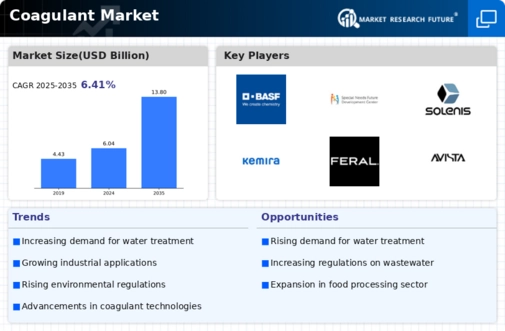Market Share
Coagulant Market Share Analysis
In the bustling realm of the Coagulant Market, devising effective market share positioning strategies is imperative for companies to thrive amidst competition. One pivotal strategy involves product differentiation. By developing coagulants with unique characteristics such as enhanced efficiency, versatility across different applications, or eco-friendly formulations, companies can cater to diverse customer needs and carve out a distinct market segment. Investing in research and development to continually enhance product performance and introduce innovative solutions can further bolster a company's competitive edge, making its offerings more attractive to customers and bolstering market share.
Pricing strategies also play a crucial role in market positioning. Companies can strategically price their coagulants to appeal to different customer segments. Offering premium-grade products at a higher price point can target customers who prioritize quality and are willing to pay more for superior performance and reliability. Conversely, introducing more cost-effective options can attract price-conscious buyers and capture a larger market share. Implementing dynamic pricing tactics such as bulk discounts, promotional bundles, or seasonal offers can also help companies adapt to market dynamics and maximize sales volume. The growth of the coagulants market is primarily attributed to the stringent regulations associated with the discharge and disposal of wastewater from the industries. The continuous growth in the volume of untreated wastewater, as well as the release of hazardous chemicals and materials into water bodies, have created an urgent need to monitor and control water quality.
Furthermore, effective marketing and branding are essential for establishing a strong market position. Building a compelling brand identity that resonates with target customers can significantly influence purchasing decisions. Investing in comprehensive marketing campaigns across various channels, including digital platforms, industry conferences, and trade publications, can help raise brand awareness and visibility. Additionally, highlighting the unique features and benefits of coagulants, such as rapid action, minimal dosage requirements, or compatibility with different water treatment processes, can differentiate a company's offerings in the market and attract a loyal customer base.
Collaboration and strategic partnerships can also be instrumental in expanding market share. By forming alliances with distributors, water treatment plants, or industrial manufacturers in key sectors such as wastewater management, pulp and paper production, or mining, companies can extend their market reach and gain access to new customer segments. Moreover, forging strategic partnerships with suppliers of complementary products or services, such as flocculants, filtration systems, or process chemicals, can create synergies and mutual benefits, enabling companies to leverage each other's strengths and capture a larger share of the market.
Moreover, customer-centric approaches are vital for building lasting relationships and fostering brand loyalty. Providing exceptional customer service, technical support, and ongoing maintenance can enhance customer satisfaction and retention. Actively seeking feedback from customers and incorporating their input into product development can demonstrate a commitment to meeting their evolving needs and preferences. Additionally, offering value-added services such as onsite training, troubleshooting assistance, or customized solutions can further differentiate a company's offerings and solidify its position in the market.













Leave a Comment